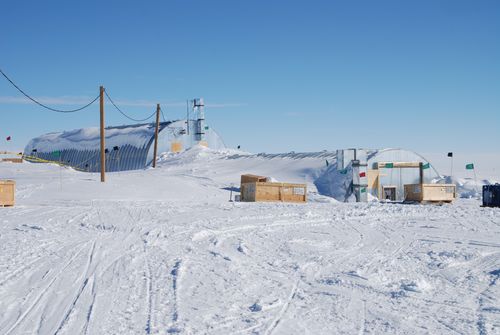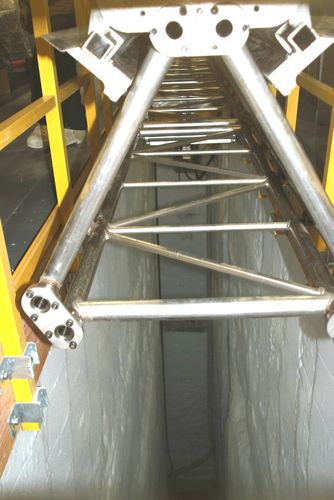Happy Birthday Krystal!!!
WAIS Divide 1-21&22- 08
Local Posting Day and Time- 1-26-08 7:28 PM
Central Standard Posting Day and Time- 1-26-08 12:28 AM
WAIS Divide Weather
Temperature- 0 F
Wind Direction- East
Wind Speed- 11 MPH
Wind Chill- -15 F
Answer to Previous WATIZIT
Congratulations to Jeff for figuring out that the whale is a Minke Whale!!!
Congratulations to Abby and the rest of 3W class for figuring out the solar panel WATIZIT. (I hope I didn't miss anyone else who figured it out.)
Today’s WATIZIT Picture
 WATIZIT
WATIZIT
WATIZIT
The trip to WAIS Divide!!!! Where do I start???? So much has happened in just the past few days.
You can follow our routes from the past few days if you have a map of Antarctica with latitude and longitude. You can also look at the AWS website to get a general view of our journey.
Fly From: Willie Field (in an LC130 Hercules)- 77.9 S and 167 E
To: WAIS (Kaminko-Slade AWS)- 79.5 S and 112 W
From WAIS (In a Twin Otter) 79.5S and 112 W To: Theresa AWS- 84.6S and 115.8 W To: Briana AWS- 83.9 S and 134 W back to WAIS
From WAIS (In a Twin Otter)- 79.5 S and 112 W To: Byrd AWS- 80 S and 119 W To: Swithinbank AWS- 81 S and 126 W back to WAIS
From WAIS (In an LC-130 Hercules) back to Willie Field.
Monday George and I were scheduled to fly to WAIS, but the flight was canceled. Tuesday eight of us boarded an LC-130 Hercules aircraft for the 3 and a half hour flight to WAIS divide. (Notice where the door is located, on the trip back from WAIS we boarded the LC-130 with the props spinning.)
 George and LC 130
George and LC 130
George headed to the LC-130 Hercules
We packed ourselves in amongst the cargo. Right beside us were 4 pallets of 55 gallon drums full of a flammable liquid. Once in our seats, we were handed earplugs because the 4 engine prop plane is very noisy inside. I spent a large amount of time in the cockpit. Over the roar of the engines I visited with the pilot and copilot. The crew includes the pilot, copilot, navigator, engineer and two loadmasters. All have at least a 4 year college degree.
 LC130 Cockpit
LC130 Cockpit
LC-130 Hercules Cockpit
WAIS Divide camp is at the crest of the West Antarctic Ice Sheet (WAIS), kind of like the continental divide in the U.S.. This spot was very specifically selected to be the best location to drill to the bottom of the 2 mile thick ice sheet. A major drilling facility has been built here, called the Arch. From the outside it looks like it could be a farm building somewhere in the Midwest.
 WAIS Arch
WAIS Arch
WAIS Drilling Arch
Although drilling has stopped for the year and the camp is being shut down before winter hits, the chief driller gave us a tour of the facilities.
 Entering the Arch
Entering the Arch
Entering the Arch
This was the first year of production drilling and in only 2 weeks of drilling they were able to extract ice all of the way back to 300 B.C., about 580 meters.
 Drilling equipment inside the arch
Drilling equipment inside the arch
Drilling Tower is silver structure inside yellow railing.
We watched the ice cores being loaded onto an LC-130 to start their trip to Denver for further analysis. These ice cores can give scientists a look backward in time at past climatic changes. Once drilling is completed and all of the ice cores are analyzed scientists should be able to look back in time almost 100,000 years, and compare this climate record to ice cores from Greenland.
 Drilling tower flips vertically over/into drilling pit.
Drilling tower flips vertically over/into drilling pit.
Drilling tower flips vertically over/into drilling pit.
Our goal though for coming to WAIS is to repair instruments collecting current real time weather data, not ancient climate data. The data from "our” (I have been here long enough now, that I am thinking in terms of "ours” rather than "theirs”) weather stations is being use for two primary purposes. One is for logistics- weather forecasting for flying scientists to WAIS and elsewhere around Antarctica. The other is for research comparisons with other scientific projects. More about these stations later.

